In today’s rapidly evolving entertainment landscape, Internet Protocol Television (IPTV) has emerged as a game-changer for how Americans consume television content. As traditional cable subscriptions continue declining and streaming services multiply, IPTV offers a unique middle ground that combines the best features of both worlds. But how exactly does this technology work behind the scenes? Understanding IPTV technology isn’t just for tech enthusiasts—it’s essential knowledge for any US consumer looking to make informed decisions about their entertainment options. This guide will break down the complex mechanics of IPTV into digestible insights, helping you understand why millions of American households are making the switch to this innovative delivery method.

What Exactly is IPTV? The Fundamental Definition
IPTV (Internet Protocol Television) delivers television content over Internet Protocol (IP) networks instead of through traditional satellite or cable formats. Unlike standard internet streaming platforms like YouTube or Netflix that use the public internet to deliver on-demand content, professional IPTV services provide live television channels, time-shifted media, and video-on-demand content in a more structured, reliable format specifically designed for television consumption. The key distinction lies in the delivery mechanism—where traditional broadcasting sends signals through dedicated physical infrastructure, IPTV leverages your existing broadband connection to transmit television programming using the same protocols that power the internet itself.
The term “IPTV” is often confused with general online video streaming, but they’re fundamentally different technologies serving different purposes. While streaming services prioritize on-demand content accessible through web browsers, IPTV functions more like traditional television but delivered via your internet connection. As noted by industry expert Burnell Chenard, “Unlike standard internet streaming, professional IPTV providers like DezorTV offer live television channels, time-shifted media, and video-on-demand content in a more structured, reliable format” linkedin.com. This distinction is crucial for US consumers navigating today’s complex entertainment marketplace.
“IPTV works by breaking down video content into data packets and transmitting them over the internet. These packets are reassembled by your receiving device (smart TV, set-top box, or application) to display seamless video content.”
— Burnell Chenard, IPTV Industry Expert
The Technical Mechanics Behind IPTV Delivery
Data Transmission Process
At its core, IPTV technology converts television signals into digital data packets that travel across IP networks. This process begins at the content provider’s headend, where broadcast signals are encoded into digital format and segmented into small data packets. These packets are then transmitted across your ISP’s network using specific protocols designed for efficient video delivery. Unlike standard web traffic, IPTV uses specialized transmission methods such as unicast, multicast, and broadcast streaming to optimize bandwidth usage depending on the service type.
Unicast delivers content to individual users (ideal for VOD), multicast sends content to multiple users simultaneously (perfect for live TV), and broadcast reaches all users in a network segment. Your receiving device—whether it’s a smart TV, dedicated set-top box, or mobile application—then reassembles these data packets in the correct sequence to produce smooth, high-quality video. The entire process happens in milliseconds, creating the illusion of continuous playback despite the underlying packet-based transmission.
Middleware: The Hidden Powerhouse
Behind every seamless IPTV experience lies sophisticated middleware software that acts as the crucial bridge between the IPTV operator and your end-user device. As documented in technical documentation, “This software acts as a crucial bridge between the IPTV operator and the end-user device. It manages a wide array of functions, including user authentication, content delivery, and various service management aspects” perio.org. This middleware platform handles everything from electronic program guides (EPG) to parental controls, payment processing, and personalized recommendations.
Modern IPTV middleware also enables advanced features that set it apart from traditional cable services:
- Catch-Up TV: Watch programs that aired in the past few days or weeks, even if you didn’t record them (typically limited to a specific window like the last 7 days)
- Start-Over: Join a live program from the beginning even after it’s started
- Time-Shifted Media: Pause and rewind live television
- Personalized Content Recommendations: AI-driven suggestions based on viewing habits
IPTV Service Models Available to US Consumers
| Service Type | How It Works | Best For | Bandwidth Requirements |
|---|---|---|---|
| Live IPTV | Real-time streaming of broadcast channels | Sports, news, live events | 15-25 Mbps per stream |
| Time-Shifted TV | Programs available for replay after original broadcast | Viewers with scheduling conflicts | 10-15 Mbps |
| Video on Demand (VOD) | Library of content available anytime | Movie/series enthusiasts | 10-20 Mbps |
| Near Video on Demand (NVOD) | Scheduled repeated showings of popular content | Popular event viewing | 15 Mbps |
The three primary service models available to US viewers each serve different viewing needs while leveraging the same underlying IPTV technology. Live IPTV delivers traditional broadcast channels in real-time, functioning much like conventional cable but via internet protocol. Time-shifted television, as explained by industry resources, allows viewers to “Watch programs that have aired in the past few days or weeks, even if you didn’t record them. This is often limited to a specific window (e.g., the last 7 days)” whitelabelwonder.com. Video on Demand provides access to extensive content libraries that users can access at their convenience.
One critical advantage of IPTV over traditional streaming is quality consistency. Many providers now offer enhanced visual experiences: “High-Quality Streaming: Especially with 8K IPTV, the quality is unmatched. Fewer Ads: Many IPTV providers offer ad-free packages” prime4ktv.com. This focus on premium viewing experience represents where the technology is heading in the competitive US market.
Requirements for Optimal IPTV Performance
Technical Requirements
For US viewers to enjoy a seamless IPTV experience, certain technical specifications must be met. First and foremost is your internet connection—unlike casual web browsing, IPTV demands consistent bandwidth and low latency. Most quality IPTV services recommend:
- Minimum download speed of 25 Mbps for HD content
- 50+ Mbps for multiple simultaneous streams or 4K content
- Wired Ethernet connection preferred over Wi-Fi for stability
- Low latency (under 40ms) for live event watching
- Minimum 95% packet delivery rate
Your equipment matters just as much as your internet connection. Dedicated IPTV set-top boxes typically deliver the most reliable experience, though many modern smart TVs include IPTV functionality. When evaluating devices, look for:
- Hardware-accelerated video decoding
- Sufficient RAM for smooth multitasking
- Modern video codec support (H.265/HEVC preferred)
- Ethernet port for wired connection
- Multiple HDMI outputs for multi-room setups
Pro Tip: Many IPTV issues stem from Wi-Fi interference. For the most stable experience, connect your IPTV device directly to your router via Ethernet cable. If you must use Wi-Fi, choose 5GHz band over 2.4GHz for less interference and higher bandwidth.
Quality of Service (QoS) Configuration
Advanced users can significantly improve IPTV performance by configuring Quality of Service (QoS) settings on their home router. QoS prioritizes IPTV traffic over less time-sensitive internet activities like email or file downloads. For US households with multiple internet users, this configuration prevents video buffering when others are online. Most modern routers allow you to prioritize IPTV traffic by:
- Identifying your IPTV device’s MAC address
- Assigning higher priority to video streaming protocols
- Reserving minimum bandwidth for IPTV streams
- Limiting bandwidth for non-essential devices during peak viewing times
Without proper QoS configuration, activities like large file downloads or video calls can disrupt your IPTV experience—something cable TV subscribers never had to consider.
The Legal Landscape of IPTV in the United States
US consumers face critical legal considerations when choosing IPTV services. The entertainment industry has become increasingly vigilant about protecting content rights, with “Governments and content providers… cracking down on illegal IPTV services, enforcing stricter copyright regulations” vocal.media. Legitimate IPTV services secure proper licensing for all content they distribute, while unauthorized services often operate in legal gray areas or outright piracy.
When evaluating IPTV providers, watch for these red flags indicating potentially illegal services:
- 🚩 Extremely low pricing (e.g., $10/month for thousands of channels)
- 🚩 No formal business address or legitimate contact information
- 🚩 Services requiring obscure payment methods (cryptocurrency-only)
- 🚩 Lack of proper privacy policy and terms of service
- 🚩 Promises of “premium channels” without network authorization
Law-abiding US consumers should only consider services that transparently disclose their licensing arrangements. The market’s increasing regulation means “IPTV providers face stiff competition from established streaming giants like Netflix, Disney+, and YouTube. To remain relevant, IPTV services must continuously innovate and offer exclusive content” vocal.media.
Pro Tip: Always check if the IPTV service offers a free trial period. Reputable US-based providers typically offer 24-72 hour trials: “Most top-tier IPTV providers offer a free trial IPTV period. During this time, you can test streaming quality, channel variety, and overall service reliability” prime4ktv.com. This allows you to evaluate legitimate services without financial risk.
Choosing the Right IPTV Service for Your US Household
Not all IPTV providers deliver the same experience, especially in the diverse US media market. When comparing services, consider these critical factors:
Content Selection & Regional Availability
- US-specific channel lineups (local broadcast networks, cable channels)
- Sports package options (regional sports networks, premium sports)
- International channel availability if needed
- Content licensing for your specific state/region
Technical Performance Metrics
- Verified streaming quality (HD, 4K, 8K availability)
- Infrastructure reliability (uptime statistics)
- Device compatibility with your existing ecosystem
- Customer support responsiveness
Business Practices & Transparency
- Clear pricing structure with no hidden fees
- Legitimate business registration and contact information
- Transparent privacy policies compliant with US regulations
- Established history in the US market
| Feature Checklist | Essential | Recommended | Luxury |
|---|---|---|---|
| US-based customer support | ✓ | ||
| Local broadcast channels | ✓ | ||
| 99.9% uptime guarantee | ✓ | ||
| 4K streaming capability | ✓ | ||
| Multi-room viewing | ✓ | ||
| 8K future-proofing | ✓ |
The Future of IPTV Technology in America
The US IPTV market continues evolving rapidly as providers innovate to compete with traditional cable and streaming giants. Industry analysis predicts several key developments will shape the next generation of IPTV services:
- Enhanced Interactivity: Future IPTV platforms will incorporate more interactive features, allowing viewers to participate in live polls, access supplementary content during shows, and customize viewing experiences in real-time.
- AI-Powered Personalization: Advanced machine learning algorithms will deliver hyper-personalized content recommendations and adaptive user interfaces that evolve with viewing habits.
- 8K Resolution Adoption: As highlighted in emerging trends, “The IPTV market is competitive, and that’s great news for users. Most top-tier IPTV providers offer… 8K IPTV, the quality is unmatched” prime4ktv.com. While still emerging, 8K content will become more prevalent as display technology advances.
- 5G Integration: Next-generation wireless networks will enable true mobile IPTV experiences with reduced latency and higher reliability, making high-quality television available anywhere with 5G coverage.
- Voice-Controlled Interfaces: Seamless integration with smart home ecosystems will make voice the primary interface for channel changing, content discovery, and DVR functionality.
Making the Smart Switch to IPTV
For US consumers, understanding how IPTV technology works empowers you to make informed entertainment choices in today’s fragmented media landscape. Unlike cable television’s rigid bundles or streaming services’ fragmented content libraries, IPTV offers a balanced solution delivering professional-grade television experiences through modern internet infrastructure.
As the technology matures, American consumers should prioritize services that demonstrate technical excellence, legal compliance, and customer-focused innovation. The most successful IPTV providers recognize that “the future of IPTV looks promising, with emerging technologies set to enhance its capabilities further” vocal.media, ensuring viewers receive increasingly sophisticated and reliable entertainment experiences.
Whether you’re a cord-cutter seeking to replace cable, a sports enthusiast wanting reliable live event coverage, or a tech-savvy viewer exploring next-generation television experiences, understanding IPTV’s underlying technology helps you navigate the marketplace with confidence. By choosing legitimate services with robust technical infrastructure and proper content licensing, US viewers can enjoy the best that modern television technology has to offer—without compromising on quality, legality, or viewing enjoyment.
